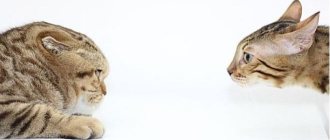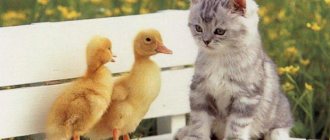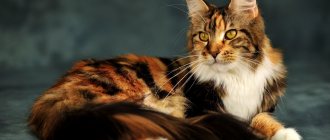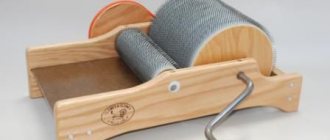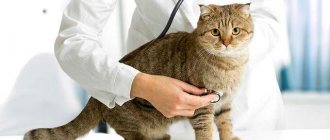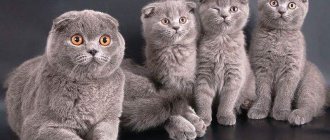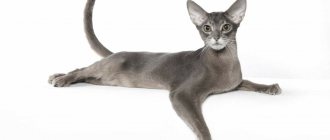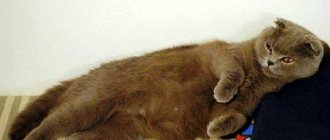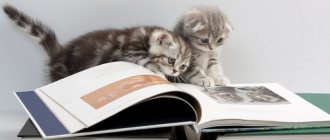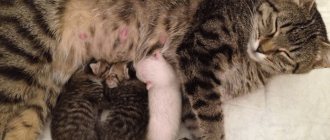Sample cat pedigree
Note: The pedigree of a Scottish cat or the pedigree of a Sphynx is no different from the pedigrees of cats of other breeds; all differences in the design of pedigrees of cats are determined by the rules and aesthetic preferences of clubs and systems, and therefore do not play any significant role.
Pedigrees for cats are issued by clubs or the systems themselves directly.
How documents are made for purebred cats
How to get breeding documents for a cat? It all depends on the availability of metrics. If you have it in your hands, contact the club that issued it. Processing times are 2-3 weeks.
If you purchased a pet in another city or country, contact the club by mail. In a response letter, the organization will send a finished pedigree or copies of the parents’ pedigrees. After receiving copies, contact your local club that is in the same system as the club that issued the metrics. Most organizations are cooperative when issuing such documentation.
Without a cat’s birth certificate, there are 2 possible solutions to the problem:
- Contact the breeder
. If you are sure that the mating is legal and that the pet’s parents have a pedigree, contact the seller. Refusal to transfer the metric is possible due to the expiration of its expiration date (one year from the date of birth of the kitten) or the presence of defects that put an end to further breeding.
- Obtaining a certificate of conformity to the breed
. You can find out how to get documents for a kitten without a pedigree in a club or felinological association. This option is relevant in the absence of documentation, but there is obvious similarity with the standard of a particular breed. After assessment, the pet is given a zero pedigree, which gives the right to participate in experimental breeding.
Other methods of obtaining a pedigree are considered fraudulent. Felinologists recommend refusing mating if you have a certificate of conformity. The results of such crosses are unpredictable and can have a negative impact on the offspring.
Providing all necessary documentation at the time of sale is a reliable way to identify a responsible seller. Regardless of the future prepared for the new family member, make sure you have the required papers. They may not be useful, but if the initial decision changes, they are guaranteed to save you from unnecessary actions and worries.
Pedigree of a cat: general rules for registration
1) Emblem of the association (system) of cat shows (upper left corner on the example)
It is important that it is there, no matter where the emblem is located and which association (system) it belongs to (most associations mutually recognize each other's pedigrees).
2) Emblem and/or name of the cat lovers club (on the example of the cat’s pedigree, upper right corner).
3) Hat: inscription Pedigree certificate or Pedigree or Pedigree; number (the number most often indicates the abbreviation of the club (IFC), the number itself (045), the year of issue (06), the abbreviation of the breed (BUR), sometimes the abbreviation of the country (RU)).
4) Information about your cat: nickname\name, breed, color, date of birth, gender (sometimes gender is written in numbers 1.0 - cat; 0.1 - cat), full name of the cat breeder, full name of the owner (usually everything is written completely without abbreviations).
5) A plate with information about ancestors: 3-4 (rarely more) generations (from parents to great-great grand parents).
6) Signature of the head/president/responsible representative of the club/system of cat lovers who issued the cat’s pedigree, and the seal of this club/system (on the sample below).
7) The cat's pedigree is written in English or Russian, or both (for example, if some names of ancestors in official documents are used only in English or vice versa).
Good clubs/systems laminate the cat’s pedigree.
It is worth noting that if in European systems pedigrees are issued by the club, then in American systems it is the system itself, therefore the document issued by the latter will lack data related to the club and seals. Also, pedigrees issued abroad may differ significantly in appearance from pedigrees issued in the CIS. However, the system logo, someone’s signature and the necessary information about the cat must be present.
Now let's move on to the details, or rather, to the tablet with the ancestors.
Why do they issue documents for animals?
Having documents for a cat is a prerequisite for participation in exhibition events. If a pet is bought for the soul and does not plan to receive honorary titles, then this is not a reason to refuse official registration. A basic set of documentation is necessary not only for exhibitions, but also for:
- Border crossing
. Moving to another country or another city within the country will be impossible without providing the required papers for a pet.
- Solutions to controversial issues
that arise when a pet is kidnapped or lost. Trying to prove ownership in court with words alone is a lost cause.
- Proof of breeding value
. The desire to breed a breed can come spontaneously. If everything is prepared in advance, you won’t have to look for where to buy documents for a cat. You will also have to deal with mandatory paperwork after the birth of kittens.
Before purchasing, familiarize yourself with what all the necessary papers look like. This will eliminate the subsequent search for information on how to prepare documents for a kitten yourself.
Eye colors:
- 61 – blue – light blue (for whites);
- 62 – yellow, golden – yellow, golden;
- 63 – oddeyed – difference of eyes;
- 64 – green – green;
- 65 – burmese – Burmese;
- 66 – tonkinese – thin;
- 67 – siam, hymalayan – Siamese blue.
For solid (solid) colors (except white), only orange eye color is acceptable (the number is not indicated in the code).
For white color - orange, blue, odd-eyed (indicated by the number 61, 62, 63, respectively).
For tabby (drawn) colors WITHOUT silver and gold - only orange (the number is not indicated in the code).
For silver tabbies (xs 22, xs 23, xs 24, xs 25), silver chinchillas (xs 12) and silver shaded (xs11) (where x is the color code) – green (the number is not indicated in the code) or orange (indicated by the number 62 (for example, ns 22 62), such colors are also called pewter).
For golden tabbies (xy 22, xy 23, xy 24, xy 25), golden chinchillas (xy 12) and golden shaded (xy 11) - only green (the number is not indicated in the code).
For color points - if the code contains the number 33 indicating color points, in any case the eyes will be blue, no matter what the original color was (not indicated in the code).
Eg:
- BRI ns 11 – black shaded – green eyes;
- BRI ns 11 33 – black shaded point – blue eyes.
For colors with white (bicolors - code 03, harlequins - code 02, vans - code 01) - the eye color corresponds to the main color. Also, some systems allow different eyes (the color of one eye corresponds to the color, the second is blue, coded 63) and blue eyes (coded 61).
Eg:
- BRI a 03 – blue bicolor – orange eyes;
- BRI fs 22 02 – silver marbled black harlequin tortoise – green eyes;
- BRI n 01 63 – black odd-eyed van.
Now let's go back to the pedigree. It presents in table form the animal’s ancestors – parents, grandparents, great-grandparents and great-great-grandparents. Parents should be recorded with pedigree numbers and names, and their names should be preceded by their titles, if any, as well as their breed and color. The same information is written about grandfathers and great-grandfathers, grandmothers and great-grandmothers. But information about great-great-grandparents and great-great-grandmothers in WCF pedigrees is often written down without the pedigree number, in order to put everything on one sheet. In FIF pedigrees, as a rule, complete information is included in the great-great… .
Almost every felinological organization has its own coding system for recording the breeds and colors of cats. So, in the SFA this is Breed/Color Designation Charts - a system of digital codes (for example, 0500 - a cat of the Russian Blue breed), in the FIF and the WCF they use the alphanumeric Easy Mind System - EMS codes (the same cat will be designated as RUS a ), and when registering with TICA, the cat will be registered as RB blue (see the article “TIKA breed codes and colors”). In addition, when a cat is registered in any system, it receives an individual registration number, which is also a pedigree number: in the SFA, our cat’s registration number will be, for example, 0500-1677465, in TICA - SBT 030109 046, in FIFA (depending on the country , in which the cat will be registered), for example, in Russia, (RU) ARCCA LO 15468, and in the VCF system, each club maintains its own registration book, so our cat’s registration number can be either SP-68/05 RG, or FCA 164/0301 /2009 RUS-K. Each registration number has a meaning. It is not necessary to know it, but sometimes it can be useful (for example, to be able to congratulate a familiar cat on his birthday or to estimate how purebred he is).
THE REGNOMER IN TICA CONSISTS OF THREE PARTS
The first two characters indicate the cat's status code, which immediately makes it clear whether the cat has three generations of ancestors of the same breed or whether there are ancestors of other breeds of domestic or even wild cats in its family.
- SB - Stud book code - the cat within the three-generation pedigree has no unknown, unregistered ancestors, or cats of other breeds or breed groups, this is a purebred animal;
— EB — Experimental Book Code — the cat within the three-generation pedigree has no unknown, unregistered ancestors, or cats of other breeds, but the cat breed itself is experimental;
— Other letters and numbers at the beginning of the registration number mean that the cat is registered in the Foundation Registry - the Basic Registry and not everything is so simple in its pedigree (more on this later).
The third letter after SB or EB (when registering experimental breeds, the same principles are used as when registering recognized ones) in the registration number can mean the following.
T (Traditional) - three tribes of a cat’s ancestors are represented by animals of only one breed, for example, only Maine Coons, if the cat is a Maine Coon, or only Abyssinians, if she is an Abyssinian, well, or only elves (which, as is known, are representatives of an experimental breed, based on crossing American Curls and Sphynxes).
V (Variant) - within a three-generation pedigree, the cat had representatives of another breed of the same breed group (in TICA, long-haired and short-haired variations of the same breed are considered different breeds; therefore, breeds that have practically the same standard with the exception of any one characteristic (hair length or color) are combined into one breed group. Thus, one breed group consists of long-haired (LH) and short-haired (SH) American Curls, LH and KSH Kuril Bobtails, LH and KSH Selkirk Rex, LH and KSH Siamese, LH and KSh British, etc. .d.).
P (Permissible) - the cat’s pedigree records permitted interbreeding. Such matings are aimed, first of all, at the development of the breed, as a rule, to expand its gene pool.
N (Non-Permissible) - unauthorized interbreeding of cats of different breeds from different breed groups.
S (Species) - interspecific crossing with wild cats. Similar matings are used when breeding new breeds (for example, Chausie or Savannah cats, when domestic cats are mated to, for example, servals or Asian leopard cats).
Thus, we have learned to understand the registry numbers of cats registered in the TICA Stud book and we can safely say that your cat’s registration number SBT 022610 055 means that: - the cat belongs to one of the TICA recognized breeds (there are only 73 of them) and is a purebred; - the cat was born on February 26, 2010 - the six digits after the letter code represent the cat’s date of birth in American format (first the month, then the day and year); — together with yours, 54 more cats celebrate their birthday on February 26th. The fact is that the last three digits in the regnomer mean the number of cats of the same breed born on the same day.
- the cat was born on February 26, 2010 - the six digits after the letter code represent the cat’s date of birth in American format (first the month, then the day and year); — together with yours, 54 more cats celebrate their birthday on February 26th. The fact is that the last three digits in the regnomer mean the number of cats of the same breed born on the same day.
If a cat is registered in the Foundation Registry - the Basic Registry, i.e. is not a purebred three generations back, such cats are registered in TICA taking into account the ancestors in the pedigree (known or not) - Ancestry Record , taking into account the ancestors of another breed in the pedigree - Hybridization Record and if there are unknown ancestors and cats of other breeds in the pedigree, an entry in The TICA database about the cat will be combined - Combined Ancestry and Hybridization Record .
A record based on the presence or absence of ancestors (Ancestry Record) implies the following - in one of the three tribes of the pedigree the cat had an unknown (meaning a mongrel cat, a domus, or non-standard pedigree cats, for example, straight-eared curls) or an unregistered ancestor (although, more precisely talk about a certified ancestor, i.e. a cat whose breed has been confirmed by three all-bred TICA judges, guided by the compliance of its phenotype with a standard (for example, it could be a certified Siberian or a Kurilian Bobtail that was found in the forest). With Ancestry Record, the status code shows in which generation the unknown or unregistered ancestor : - 01 - in the first generation, i.e. either the cat’s mom or dad were, so to speak, unknown or unregistered; - 02 - an unknown or unregistered ancestor was in the second generation, - 03 - an unregistered or unknown ancestor was in the third generation of your cat's pedigree.
Thus, if an American Curl has a registration number, for example, 03V 032410 048, this means that in the third generation of its pedigree there is an unknown or unregistered ancestor (most likely, a domus), the letter V means that the ancestors of DSh and KSh are found in the pedigree, and he was born on March 24, 2010, along with 47 other American Curls around the world.
The entry in the Hybridization Record implies that all three generations of the cat's ancestors are known, but matings of different cat breeds (not belonging to the same breed group) took place. With Hybridization Record, the first letter of the status code indicates the knee in which there was an interbreed mating : - A0 - in the first generation, the cat’s parents were of different breeds; — B0 – in the second generation the cat had ancestors of different breeds; - C0 - in the third generation of the cat’s pedigree, someone ran through it))
This means that if your Selkirk Rex has registration number BOP 101010 010, it is clear that in his second generation there was mating of different breeds of cats (for example, Selkirk and Brittany), and the letter P means that such outcrosses are acceptable for Selkirks.
Combined (Combined Ancestry and Hybridization Record), taking into account ancestors and interbreedings, recording a cat’s data in the TICA database implies that within three tribes of the pedigree there are unregistered (unknown) ancestors and interbreedings have taken place. The status code in this case is a combination of the previous two.
Thus, the regnomer of the sphinx type A2P 021508 034 means that: - A - the cat’s parents were of different breeds (for example, sphinx and Devon rex), - number 2 means that in the second generation the cat had an unknown or unregistered ancestor (for example, EKSH stood for the Devon Rex); - letter T - everyone, thank God, had the same length of wool; - well, the numbers - date of birth and the number of same-breed birthday people, hurray!
The pedigrees of cats registered with TICA are sometimes wonderful and surprising. But they are loved, proud of them, registered, and, of course, exhibited at the TICA show. Moreover, most cat owners show their pets for the first time without registration, in order to try out what and how, and only then, especially if the cat was shown successfully and reached the finals of the rings, they send a completed registration form, a scan of the pedigree (and, often, a request for registration titles) in the EO TICA.
As a rule, all registration processes go without a hitch and we get another TICA lover into our company. But sometimes, like a bolt from the blue, letters like this come
In order to never be upset at least about this, we advise you to carefully read further, and also study the TICA Registration Rules .
In TICA, all cat breeds are divided into 6 categories, each of which has its own requirements for registration with TICA and their admission to the championship. In order to take part in the TICA show and win titles, it is not enough to be a representative of a recognized breed, for example, a Maine Coon, it is necessary that your Maine Coon’s three-generation pedigree consists only of Maine Coons, etc.
The first category of cat breeds is Established breeds - established, established breeds that arose as a result of breeding work. The following cat breeds fall into this category:
| Abyssinian American Shorthair American Wirehair Balinese Bengal / Bengal LH Birman | Bombay Burmese British SH/ British LH Egyptian Mau Exotic Shorthair Havana Himalayan | Maine Coon/Mainecoon Poly Oriental/Oriental Longhair Australian Mist Persian Pixiebob/Pixiebob LH Chausie | Ragdoll Russian Blue Siamese Somali Toyger Savannah |
The first category consists of established cat breeds, the representatives of which practically correspond to the standard of their breeds.
Breeds in this category have a large and accessible gene pool, so mating with cats of other breeds (with the exception of matings within their own breed group) to improve the type, increase vitality, obtain new colors, etc., is, in principle, not required. The likelihood of discovering cats from the first group of unregistered origins (foundations), which could significantly improve the breed, is minimal. Therefore, cats of the first category of breeds within a three-generation pedigree cannot have unknown (domus, for example), unregistered (certified) ancestors, or cats of other breeds or breed groups (with the exception of ancestors of the same breed group, for example, DS and KS pixies beans), and their registration number can only begin with SBT(V). Otherwise, representatives of these breeds do not have the right to take part in the championship.
The second category of breeds is Natural Breeds , natural or aboriginal breeds (originating, for example, from Siberia, Thailand or Norway), obtained as a result of natural selection. The following cat breeds fall into this category:
| Chartreux Cymtic Japanese Bobtail SH/LH Korat | Kurilian Bobtail SH/LH Manx/Cymric Norwegian Forest Khao Manee | Siberian Singapore | Thai Turkish Angora Turkish Van |
The second category includes native cat breeds.
The rocks are open, i.e. In order to increase the gene pool, matings with representatives of the breed that have unknown ancestors (with certified cats, foundations) are permissible. It is generally accepted that when interbreeding cats of the second category of breeds, there is a high probability of losing more than winning (primarily the breed type). As a rule, cat breeds of the second category developed in certain geographical areas where bright representatives of the breed can still be found among cats living on their own (strays or picked up from the street, etc.). Therefore, cats of the second category of breeds within the three-generation pedigree should not have representatives of other breeds or breed groups, however, the presence of unknown or unregistered ancestors is allowed, and their registration numbers can only begin with SBT (V, P), 01T (V), 02T ( V) or 03T (V) . Otherwise, representatives of these breeds do not have the right to take part in the championship.
The third category of breeds is Variant or Mutation breeds , obtained as a result of the fixation of genetic mutations.
Cats of the third category of breeds differ from their mother and other breeds by one genetically fixed trait that arose as a result of random mutation or outcrosses. Regardless of their origin, these breeds are still in active development and often require mating with representatives of the parent breed in order to improve the type or increase their own gene pool. With a few exceptions, matings to unrelated breeds are not as productive for third category cats as matings to the parent breed.
Cats of the third category of breeds within a three-generation pedigree cannot have unknown, unregistered ancestors or outcrosses to other cat breeds, unless such a possibility is specified in the breed standard. Therefore, a list of breeds of the third category is given with a list of permitted outcrosses.
| Breed | Allowed matings |
| Lykoi | domuses KSh and DSh |
| American Bobtail SH/LH* | domuses KSh and DSh |
| American Curl SH/LH* | domuses KSh and DSh |
| Cornish Rex | American Shorthair, British SH, European Shorthair |
| Devon Rex | American Shorthair, British Shorthair, European Shorthair, Burmese, Bombay, Sphynx, Siamese |
| Donskoy | domus KSh |
| La Perm SH/LH* | domuses KSh and DSh |
| Munchkin SH/LH | domuses KSh and DSh |
| Nebelung* | Russian Blue |
| Ojos Azules SH/LH* | domuses KSh and DSh |
| Scottish Fold SH/LH* | American Shorthair, British LH/SH |
| Selkirk Rex | American Shorthair, British and Persian breed groups |
| Sphynx* | American Shorthair, Devon Rex |
Domus used for outcrosses must not show any signs of mutation!
Cats of third category breeds must have registration numbers starting with SBT(V), AOP, BOP or COP to participate in the championship. If the breed standard allows incomplete pedigrees and interbreed matings are allowed (such breeds are marked in the list with an asterisk*), then cats with the following regnomers can also take part in the championship: 01T (V), 02T (V), 03T (V), A1P, B1P, C1P, A2P, B2P, C2P, A3P, B3P or C3P .
Representatives of mutant/variant breeds are not allowed to participate in the championship if they do not phenotypically meet the breed standard. Cats of the third category of breeds must be distinguished by at least one clearly defined identifying feature characteristic of this breed (i.e., long-legged munchkins, Scottish straights or straight-haired rexes are not eligible to take part in the championship).
The fourth category of breeds is Domestic Hybrid breeds , breeds obtained as a result of targeted interbreeding of domestic cats.
This category is represented by relatively new breeds resulting from crossing two (or more) existing cat breeds. In order to maintain or improve the type, it is advisable to mate with representatives of the mother breeds.
| Breed | Allowed matings |
| Minuet SH/LH | domuses KSh and DSh |
| Burmilla SH/LH | Burmese, Persian |
| Ocicat | Abyssinian, Siamese |
| Peterbald | Siamese, Oriental Shorthair, Donskoy |
| Snowshoe | American Shorthair, Siamese |
| Tonkinese | Burmese, Siamese, European Burmese |
Cats of the fourth category of breeds cannot have unknown (certified), unregistered ancestors within the three-generation pedigree. The parents can be either two registered representatives of the breed, or a representative of the breed and a representative of one of the maternal breeds, or both parents of such a cat can be representatives of two maternal breeds, therefore the registration numbers of cats of category 4 breeds must begin with SBT(V), AOP, BOP or COP .
To participate in the championship, representatives of domestic hybrid breeds must phenotypically meet the standard of their breed, i.e. differ in at least one distinct identification characteristic characteristic of a given breed.
The fifth category of breeds is Non Domestic Source breed Hybrids , these are breeds obtained as a result of crossing domestic and wild cats. Today there are no cat breeds in TIKA that fall into this category. Until May 1, 2012, Savannah breeds belonged to category 5, and until May 1, 2013, Chausie breeds.
Breeds belonging to the fifth category are obtained and developed by crossing domestic cats and one type of wild cat (for the savannah it was the serval, for the chausie it was the jung cat).
To be able to exhibit in the championship, cats of the 5th breed category must have registration numbers starting with SB, CO , or C3 , i.e. within three tribes of the pedigree there should be no outcrosses prohibited for the breed, unknown or unregistered ancestors.
The sixth category of breeds is Exprtimrntal (Developing) breeds , experimental breeds still in their infancy. This category today consists of the following breeds:
| Asian LH (Tiffanie)/SH Aphrodite LH/SH Bristol California Spangled | Ceylon Chantilly Chinese Harlequin York Chocolate | Copper European Shorthair European Burmese German Rex Mandalay | Ragamuffin Ruffle Safari Tennessee Rex Vienna Woods |
Cats of these breeds have the status “Registration Only”, they do not yet have an officially approved TICA standard, a breeding program, and the name of the breed can be changed when the breed is assigned the status of PNB (Preliminary New Breed).
In the breeding program of experimental breeds, the use of any interbreed matings, as well as matings to cats of unknown origin, is allowed. Experimental cat breeds cannot take part in any of the championship classes by definition.
Now, before taking part in your first TICA show, you can check whether your cat and its three-generation pedigree meets the requirements for championship participants: - understand whether your breed is recognized in TICA at all; - if yes, then in what class; — determine the category of breeds to which your cat belongs and understand whether it will receive a registration number valid for this breed or will be registered without the right to participate in the TICA show (for which the easiest way is to use the table below).
We hope that your Briton’s pedigree does not include a Scottish Fold in the third generation, and there are no Ocicats among the Pixie Bob’s ancestors. And if everything is ok, see you at the next TICA show!
Table of registration codes and acceptable outcrosses for cat breeds recognized for participation in the TICA Championship
*
| Category I Established Breed | Category II Natural Breed | Category III Mutant/Mutation Breed | Category IV Domestic Hybrid Breed |
| SBT(V) | SBT(V, P), 01T(V), 02T(V), 03T(V) | SBT(V), AOP, BOP, COP | SBT(V), AOP, BOP, COP |
| Matings only within a breed or breed group. No unknown (certified) ancestors. No mating with other breeds. | Matings only within a breed or breed group. Unknown (certified) ancestors in the pedigree are acceptable. No interbreed matings | Matings only within a breed or breed group. Interbreed matings - only with cat breeds approved by the standard. No unknown (certified) ancestors*. | |
| 01T(V), | 02T(V), | 03T(V) | |
| * | A1P, | B1P, | C1P |
| * | A2P, | B2P, | C2P |
| * | A3P, | B3P, | C3P |
Exceptions are allowed ONLY for breeds marked with an asterisk *
Matings only within a breed or breed group. Interbreed matings - only with representatives of the maternal cat breed(s). No unknown (certified) ancestorsAbyssinian/Somali Australian Mist American SH/WH British SH/LH Balinese Bengal / Bengal LH Birman Bombay/Burmese Chausie Egyptian Mau Exotic Shorthair Havana Himalayan Maine Coon / Maine Coon Poly Oriental LH/SH Persian Pixiebob LH/SH Ragdoll Russian Blue Savannah Siamese Somali ToygerKhao Manee Chartreux Cymric Japanese Bobtail LH/SH Kurillian Bobtail LH/SH Korat Manx Norwegian Forest Siberian Singapura Thai Turkish Angora Turkish VanAmerican Bobtail LH/SH* American Curl LH/SH* Cornish Rex Devon Rex Donskoy La Perm LH/ SH* Lykoi Munchkin LH/SH Nebelung* Scottish Fold LH/SH* Selkirk Rex LH/SH Sphynx*Ocicat Burmilla LH/SH Peterbald Snowshoe Tonkinese Minuete SH/LH